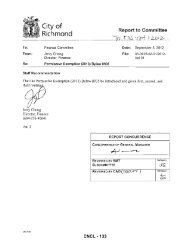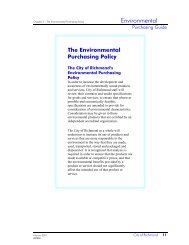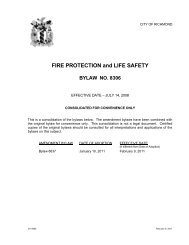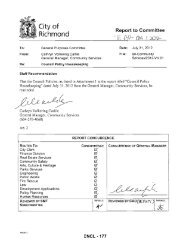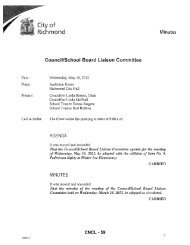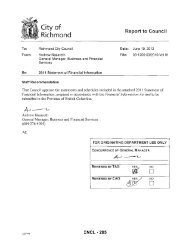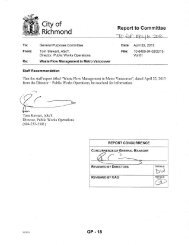Forsaken - City of Richmond
Forsaken - City of Richmond
Forsaken - City of Richmond
Create successful ePaper yourself
Turn your PDF publications into a flip-book with our unique Google optimized e-Paper software.
<strong>City</strong> <strong>of</strong><br />
<strong>Richmond</strong><br />
Report to Committee<br />
To:<br />
From:<br />
Re:<br />
Community Safety Committee<br />
Phyllis L. Carlyle<br />
General Manager, Law & Community Safety<br />
Date: January 7, 2013<br />
File:<br />
<strong>Forsaken</strong>: The Report <strong>of</strong> the Missing Women Commission <strong>of</strong> Inquiry<br />
Staff Recommendation<br />
That:<br />
1. the Ci ty work collaboratively and constructively with the Honourable Steven Point's<br />
advisory committee (the "Advisory Committee") on the safety and security <strong>of</strong> vulnerable<br />
women tasked with providing community·based guidance on the recommendations and<br />
two additional proposals contained in the report entitled, <strong>Forsaken</strong>: The Report <strong>of</strong> the<br />
Missing Women Commission <strong>of</strong> Inquiry (the "Report");<br />
2. if th e Advisory Corrunittee is not working on regional policing, that the Province be<br />
requested to act on Recommendation 9.2 <strong>of</strong> the Report by establishing an independent<br />
expert committee to develop a proposed model and implementation plan for a Greater<br />
Vancouver police force; and<br />
3. staff report back to the Community Safety Committee on the Province's progress in<br />
acting on Recorrunendation 9.2 <strong>of</strong> the Report (establishing an independent expert<br />
corrunittee to develop a proposed model and implementation plan for a Greater<br />
Vancouver police force).<br />
Phylll L. Carlyle<br />
General Manager, Law & Community Safety<br />
(604-276-4104)<br />
REVIEWED BY SMT<br />
SUBCOMMITTEE<br />
REVIEWED BY CAO<br />
REPORT CONCURRENCE<br />
~<br />
GP<br />
371690lv4<br />
CS - 65
January 7, 2013 - 2 -<br />
Origin<br />
Siaff Report<br />
On November 14, 2012, the Community Safety Committee resolved, in addition to other matters:<br />
That:<br />
(3) staff ell1er ill10 discussio1ls to determine the pl'o~1Ject <strong>of</strong>wllet"er a regional<br />
police force would be led by th e Province.<br />
On November 28,2012, Mayor Brodie wrote to the Honourable Shirley Bond, Minister <strong>of</strong><br />
Justice and Attorney General, advising that the Community Safety Committee had referred back<br />
to staff Resolution (3) above as well as a request to analyse the costs involved in pursuing an<br />
independent police department with contracted external specialized services and advised that the<br />
<strong>City</strong> <strong>of</strong> <strong>Richmond</strong> looked forward to working collaboratively with the Province on th ese<br />
important issues. Mayor Brodie asked that the Minister assign some <strong>of</strong> her staff to work with<br />
<strong>City</strong> <strong>of</strong> <strong>Richmond</strong> staff regarding these two referrals. To date the Minister has not formally<br />
responded and her staff continue to work with <strong>City</strong> representatives.<br />
On December 17,2012, <strong>Forsaken</strong>: The Report a/the Missing Women Commission o/Inquiry (the<br />
"Report") was released. A preliminary review <strong>of</strong> the Report is set out below. The purpose <strong>of</strong> this<br />
report to Conunittee is to inform it <strong>of</strong> the contents <strong>of</strong>the Report which seem most applicable to the<br />
November 14,2012 referral (3) referred to above.<br />
The Inquiry<br />
The lnquiry was tasked with inquiring into and making findings <strong>of</strong> fact respecting the conduct <strong>of</strong><br />
the investigations conducted between January 23, 1997 and February 5, 2002, by police forces in<br />
B.c' respecting women reporting missing from the Downtown Eastside <strong>of</strong> the <strong>City</strong> <strong>of</strong> Vancouver<br />
"DTES"). The Commission heard 93 days <strong>of</strong> evidence and 86 witnesses. There were 256<br />
exhibits entered encompassing over 27,000 pages. There were public hearings, written<br />
submissions, public policy forums and input from cOnuTIunity engagement forums throughout the<br />
province.<br />
The Report<br />
The 1,448 page Report was released on December 17,2012. The 63 recommendations and two<br />
additional proposals are set out in Attachment 1.<br />
The Report's recommendations fall into five major themes:<br />
1. Healing and reconciliation, and legacy.<br />
2. Policing reforms.<br />
3. Crown policy and practices.<br />
4. Missing persons' response and community engagement.<br />
5. Services and supports.<br />
373690h4 CS - 66
January 7, 2013 - 3 -<br />
Report Conclusions<br />
The Report's conclusions most relevant to the <strong>City</strong> <strong>of</strong> <strong>Richmond</strong>'s issues relating to policing<br />
models including regionalization are set out in Attachment 2.<br />
Progress since 2002<br />
The Report acknowledges that both the VPD and the RCMP have taken "meaningful steps" to<br />
improve their practices in light <strong>of</strong> the experience and Commissioner Oppal commends them for<br />
these efforts. 1<br />
Independent Advisor<br />
Recommendations 12.1 and 12.2 recommend that the Provincial Government appoint an<br />
independent advisor to serve as a champion for the implementation <strong>of</strong> the Commission's<br />
recommendations and to work collaboratively with representatives <strong>of</strong> Aboriginal communities,<br />
the DTES, and the victims' families in the implementation process.<br />
Provincial Reaction to th e Report<br />
On the day <strong>of</strong> the Report's release, Minister Bond advised:<br />
"! want to assure you, as well as all British Columbians, that our government will use these<br />
recommendations as a blueprint/or building a legacy o/safety and security for vulnerable<br />
women over the coming years. " 2<br />
In addition, the Province took the following steps:<br />
1. The Honourable Steven Point, former Lieutenant Governor, was appointed as the<br />
champion to provide advice to government as it implements the recommendations and to<br />
chair a new advisory committee on the safety and security <strong>of</strong> vulnerable women. His<br />
committee is to provide community-based guidance on the Report's 63 recommendations<br />
and two additional proposals.<br />
2. The Minister Responsible for Housing committed $750,000 to the WISH Drop-In Centre<br />
to allow them to expand the hours in which they provide services to women.<br />
3. The Ministry <strong>of</strong> Transportation and Infrastructure is developing a targeted consultation<br />
plan to address the commissioner's recommendation for safer transportation opportunities<br />
along the Highway 16 corridor.<br />
Minister Bond also advised:<br />
"We're ill the process <strong>of</strong> discussing a IO-year policing plan for British Columbia, and 1 think the<br />
concept o/what that model might/oak like deserves further discussion " She did not say which<br />
model her government would prefer. 3<br />
I Part 12 Vol lIl p. 212<br />
2 BC Government On-line News Room Release December 17,2012<br />
373690Lv4 CS - 67
January 7, 2013 - 4-<br />
In addi ti on she stated:<br />
Analysis<br />
"We heard/rom Commissioner Oppalthat it is important that we have a discussion about<br />
regional policing with mayors and leaders and {think the recommendations is very timely.<br />
Certainly, I've always been willing to sit down and discuss with local mayors in the Vancouver<br />
area to talk about that (regional policing) as an option. ,,4<br />
The Province's detailed analysis <strong>of</strong> the advantages and disadvantages <strong>of</strong> a Greater Vancouver<br />
police force is not publicly available ifit has been done. In order to perfonn this analysis,<br />
Provincial leadership is required to establish an independent expert committee to develop a<br />
proposed model and implementation plan for a Greater Vancouver police force (as set out in<br />
Recommendation 9.2).<br />
At the moment, it is unknown whether the Province will agree to the Report's recommendation<br />
to establish a Greater Vancouver police force or if the Province will seriously consider an<br />
application by the <strong>City</strong> <strong>of</strong> Riclunond to establish its own police force while using an external<br />
service provider for some functions. Clearly the creation <strong>of</strong> an independent police force is<br />
completely at odds with the regionalization recommendation. What does seem apparent however<br />
is that the Province will not agree to either a Greater Vancouver police force or to an<br />
independent <strong>City</strong> <strong>of</strong> <strong>Richmond</strong> Police force until the Province has completed its BC Policing<br />
Plan and until Mr. Point's conunittee has completed its review <strong>of</strong> the Report and provided<br />
community~based guidance on the report's 63 recommendations and two additional proposals.<br />
Financial Impact<br />
There is no financial impact associated with this report.<br />
Conclusion<br />
Staff recommend the <strong>City</strong> work collaboratively and constructively with Mr. Point's advisory<br />
committee on the safety and security <strong>of</strong> vu lnerable women tasked with providing community~<br />
based guidance on the recommendations and two additional proposals contained in the Report,<br />
and if Mr. Point's committee is not working on regional policing, that the Province be requested<br />
to act on Recommendation 9.2 <strong>of</strong> the Report by establishing an independent expert com mittee to<br />
develop a proposed model and implementation plan for a Greater Vancouver police force.<br />
Staff further recommend that staff report back to the Community Safety Conunittee on the<br />
Province's progress in acting on Recommendation 9.2 <strong>of</strong> the Report.<br />
'-- -<br />
arbara Sage<br />
Staff Solicitor<br />
(604-247-4636)<br />
J Times-Colonist December 18, 2012<br />
• Province newspaper December 17,2012<br />
3736901.4 CS - 68
January 7, 20 t3 - 5 -<br />
Attachment 1<br />
Part Thirteen Volume 3, Conclusion and Summary <strong>of</strong> Recommendations.<br />
37369
PART THIRTEEN<br />
CONCLUSION AND SUMMARY<br />
OF RECOMMENDATIONS<br />
CS - 70
<strong>Forsaken</strong>: The Report <strong>of</strong> the Missing Women Commission <strong>of</strong> Inquiry<br />
PART 13 - CONCLUSI ON AND SUMMARY OF<br />
RECOMMENDATIONS<br />
A. Conclusion<br />
As stated earlier, the Missing Women Commission <strong>of</strong> Inquiry has concluded<br />
that the police investigations into the missing and murdered women were<br />
blatant failures. I have reviewed in great detail the evidence that the<br />
cri tical police failings were manifest in recurring patterns <strong>of</strong> error that<br />
went unchecked and uncorrected over several years. Given the history<br />
<strong>of</strong> unlearned lessons <strong>of</strong> serial killer investigations, I delved further into the<br />
underlying causes <strong>of</strong> these failures and found that the causes were themselves<br />
complex and multi-faceted. I have framed my recommendations to address<br />
these complexities within the context <strong>of</strong> four overarching themes: equality,<br />
community engagement, collaboration and accountabi lity. It should come<br />
as no surprise that I have made a large number <strong>of</strong> recommendations to<br />
address these complexities: 63 in total. The recommendations dovetail<br />
one with another, each provides an additional tool, an additional check or<br />
counterbalance, an additional collaborative mechanism, all geared toward<br />
the central goals <strong>of</strong> enhancing the safety <strong>of</strong> vulnerable women and improving<br />
the initiation and conduct <strong>of</strong> investigations <strong>of</strong> missing persons and suspected<br />
multiple homicides.<br />
I have found that the missing and murdered women were forsaken twice:<br />
once by SOCiety at large and again by the police. There is no mirroring<br />
concept <strong>of</strong> "unforesaken," but together we can work toward this end by<br />
protecting and supporting vulnerable women. Together, we can and we<br />
must, build a legacy <strong>of</strong> safety to honour the missing and murdered women<br />
who are remembered and missed. In doing so, we can provide the only right<br />
answer to the question posed by Sarah de Vries' quote at the beginning <strong>of</strong><br />
my report:<br />
"Will they remember me when I am gone, or would their lives just carry on?"<br />
It is only together that we can ensure that, while the women are gone, they<br />
are not forgotten.<br />
B. Summary <strong>of</strong> Recommendations<br />
urge the Provincial Government to commit to these two measures<br />
immediately upon receipt <strong>of</strong> this report:<br />
1) To provide funding to existing centres that provide emergency<br />
services to women engaged in the sex trade to enable them to<br />
remain open 24 hours per day.<br />
2) To develop and implement an enhanced public transit system<br />
to provide a safer travel option connecting the Northern<br />
communities, particularly along Highway 16.<br />
Please note that points 1 and 2 are not formal recommendations.<br />
CS - 71
Volume 111<br />
Restorative Measures<br />
Please note that recommendations are numbered according to the Part <strong>of</strong> the<br />
Report in which they are introduced. (Example: Part 3 begins with 3, Part 4<br />
begins with 4, and so on.)<br />
I make the following recommendations in order to lay the foundation for<br />
effective change through acknowledging the harm and fostering hea ling and<br />
reconciliation:<br />
3.1 That Provincial Government appoint t'>'vo advisors, including one<br />
Aboriginal Elder, to consult with all affected parties regarding<br />
the form and content <strong>of</strong> the apologies and other forms <strong>of</strong> public<br />
acknowledgement required as a first step in the healing and<br />
reconciliation process.<br />
3.2 That Provincial Government establish a compensation fund for the<br />
children <strong>of</strong> the missing and murdered women.<br />
3.3 That Provincial Government establish a healing fund for families <strong>of</strong><br />
the missing and murdered women. These funds shou ld be accessed<br />
through an application process pursuant to establ ished guidelines.<br />
3.4 That Provincial Government appo int two advisors, including one<br />
Aboriginal Elder, to consult with all affected parties regarding the<br />
structure and format <strong>of</strong> this facilitated reconciliation process and<br />
to consider mechanisms for funding it. These consu hations and<br />
recommendations could be undertaken together with recommendation<br />
3.1.<br />
Equality-Promoting Measures<br />
I make the following recommendations in order to renew our commitment to<br />
equal protection <strong>of</strong> the law through practical measures:<br />
4.1 That the Minister <strong>of</strong> Justice direct the Director <strong>of</strong> Police Services to<br />
undertake equality audits <strong>of</strong> police forces in British Columbia with a<br />
focus on police duty to protect marginalized and Aboriginal women<br />
from violence. These audits shou ld be carried out by an external<br />
agency and with meaningful community involvement.<br />
4.2 That Provincial Government set a provincial standard establishing that<br />
police <strong>of</strong>ficers have a general and binding duty to promote eq uality<br />
and to refrain from discriminatory policing.<br />
4.3 Tha,t Provi ncial Government amend the BC Crown Policy Manual to<br />
explicitly include equality as a fundamental principle to guide Crown<br />
Counsel in performing thei r functions.<br />
4.4 That Provincial Government develop and implement a Crown<br />
CS - 72
<strong>Forsaken</strong>: The Report <strong>of</strong> the Missing Women Commission <strong>of</strong> Inquiry<br />
Vulnerable Women Assault Policy to provide gUidance on the<br />
prosecution <strong>of</strong> crimes <strong>of</strong> violence against vu lnera ble women,<br />
including women engaged in the sex trade.<br />
4,5 That Provincial Government adopt a policy statement in the BC<br />
Crown Policy Manual requiring that a prosecutor's evaluations <strong>of</strong><br />
how strong the case is likely to be when presented at trial should<br />
be made on the assumption that the trier <strong>of</strong> fact will act impartially<br />
and according to the law.<br />
4,6 That Provincial Government direct the Director <strong>of</strong> Police Services to<br />
consu lt with the BC Association <strong>of</strong> Municipal Chiefs <strong>of</strong> Police, the<br />
RCMP and community representatives to recommend the wording<br />
<strong>of</strong> a statutory provision on the legal duty to warn and a protocol an<br />
how it should be interpreted and applied.<br />
4.7 That police forces work with local communities to develop<br />
communication strategies for the issuance <strong>of</strong> warnings th at ensure<br />
the message is conveyed to community members who are most at<br />
risk <strong>of</strong> the specific threat.<br />
4.8 That Provincial Government fund three law reform research projects<br />
on aspects <strong>of</strong> the treatme nt <strong>of</strong> vulnerable and intimidated witnesses:<br />
• The effects <strong>of</strong> drug and alcohol use on memory and how to<br />
support those experiencing dependency or addiction to provide<br />
testimony;<br />
• Police. cou nsel and the judiciary's bias and perceptions <strong>of</strong><br />
credibility <strong>of</strong> people with drug addi tions or who are engaged in<br />
the survival sex trade; and<br />
• Potential changes to the Jaw <strong>of</strong> evidence to better allow<br />
vulnerable witnesses, including those who have been sexually<br />
assaulted, those suffering from Cldd ictions, and those in the sex<br />
industry, to take part in court processes.<br />
4.9 Thilt Provincia! Government develop gUidelines to facilitate and<br />
support vul nerable and intimidated wi tnesses by al! actors within<br />
the criminal justice system based on the best practices identified<br />
by the Commission through its review <strong>of</strong> protocols and guidelines<br />
existing in other jurisdictions.<br />
4.10 n,at police forces integrate into training, performance sta ndards,<br />
and performance measurement the ability <strong>of</strong> police <strong>of</strong>ficers to<br />
develop and maintain community relationships, particularly with<br />
vulnerable members <strong>of</strong> the community who are <strong>of</strong>ten at risk <strong>of</strong><br />
being treated unequally in the delivery <strong>of</strong> public services.<br />
4.11 That the BC Association <strong>of</strong> Municipal Chiefs <strong>of</strong> Police and the<br />
RCMP establish a working group to develop a best practices gUide<br />
for the establishment and implementation <strong>of</strong> formal discussion<br />
mechanisms to facilitate communication and collaboration that<br />
transcends the institutional hierarchy within a police agency.<br />
CS - 73
Volume III<br />
4.12 That police <strong>of</strong>ficers be requi red to undergo mandatory and ongoing<br />
experiential and interactive training concern ing vulnerable<br />
community members:<br />
• Active engagement in overcoming biases, rather than more<br />
passive sensitivity traini ng (sometimes ca Bed anti-oppression<br />
training);<br />
• More intensive and ongoing training in the history and current<br />
status <strong>of</strong> Aboriginal peoples in the province and in the specific<br />
community, particularly with respect to the ongoing effects <strong>of</strong><br />
residen tial schools and the child welfare system;<br />
• Training and resources to make prevention <strong>of</strong> violence against<br />
Aboriginal women a genuine priority;<br />
• Training to ensu re an understanding <strong>of</strong> violence against women<br />
in a range <strong>of</strong> settings including family violence, child sexual<br />
exploitation and violence agai nst women in the sex trade;<br />
in particular, the scenarios used in police training shou ld<br />
incorporate issues <strong>of</strong> cultural sensitivity and violence against<br />
women; and<br />
• Training in recognizing the special needs <strong>of</strong> vulnerable<br />
individuals and how to meet those needs, including recognition<br />
<strong>of</strong> a higher standard <strong>of</strong> care owed by the police to these<br />
individuals.<br />
4.13 That the Police Complaint Commissioner, working with police<br />
forces across the Province, take steps to develop, promote and refine<br />
informal methods <strong>of</strong> police discipline, particularly in marginalized<br />
communities such as the DTES and with Aborigi nal communi ti es.<br />
4. 14 That Provincial Government engage with the RCMP in order to<br />
bring them into the provincial complaints process.<br />
Measures to Enhan ce the Safety <strong>of</strong> Vulne rable Urban Wo men<br />
I make the following recommendations in order to enhance the safety <strong>of</strong><br />
vulnerable women in the OTES and other urban settings, including by<br />
listening to and learning from vulnerable women and responding to thei r<br />
needs:<br />
5.1 That SisterWatch be evaluated to provide a basis for further<br />
refinements and with a view to establishing best practices for<br />
meaningful police-community partnerships; and that these best<br />
practices be shared wi th other police forces to encou rage them to<br />
develop and maintain ongoing, collaborative community forums.<br />
5.2 TIlat all entities with proposed responsibilities under the Living<br />
in Community Action Plan commit to these priority actions that<br />
together form a strong basis for enhanC ing the safety <strong>of</strong> women<br />
engaged in the survival sex trade.<br />
5.3 That other communities be encouraged to undertake the type <strong>of</strong><br />
collaborative community engagement strategy employed by Living<br />
CS - 74
<strong>Forsaken</strong>: The Report <strong>of</strong> the Missing Women Commission <strong>of</strong> Inquiry<br />
in Community to develop an integrated strategy for enhancing the<br />
safety <strong>of</strong> women engaged in the survival sex trade.<br />
S.4 That Provincial Government fu nd additional full-time Sex Trade<br />
Liaison Officer positions in the Lower Mainland.<br />
5.5 That the <strong>City</strong> <strong>of</strong> Vancouver create and fund two community-based<br />
liaison positions to be filled by individuals who have experience in<br />
the survival sex trade.<br />
5.6 That Provincial Government undertake a community consultation,<br />
needs assessment and feasibility study concerning the reestablishment<br />
<strong>of</strong> an independent SOCiety comparable to the former<br />
Vancouver Police Native Liaison Society.<br />
5.7 That the VPD establish a position <strong>of</strong> Aboriginal Liaison Officer<br />
whose responsibilities would include assisting Aboriginal persons<br />
in their interactions with the Missing Persons Unit.<br />
5.8 That all police forces in British Columbia consider developing and<br />
implementing guidelines on the model <strong>of</strong> the Vancouver Police<br />
Department's Sex Work Enforcement Guidelines in consultation<br />
with women engaged in the sex trade in their jurisdiction.<br />
5.9 That the <strong>City</strong> <strong>of</strong> Vancouver and the Vancouver Police Department<br />
take proactive measures to reduce the number <strong>of</strong> court warra nts<br />
issued for minor <strong>of</strong>fences by:<br />
•<br />
•<br />
•<br />
R~ducing the number <strong>of</strong> tickets issued and charges laid for<br />
minor <strong>of</strong>fences;<br />
Developing gUidelines to facilitate greater and more consistent<br />
use <strong>of</strong> police discretion not to lay cha rges; and<br />
Increasing the ways in which fail ures to appea r can be quashed<br />
early in the judicial process.<br />
5.10 That courts consider making increased use <strong>of</strong> diversionary or<br />
alternative measures to dea l with bench wa rrants and breaches <strong>of</strong><br />
conditions. This is In light <strong>of</strong> the ba rriers that outstanding warrants<br />
have on the ability <strong>of</strong> vu lnerable women who are victims <strong>of</strong> violent<br />
crime to access police services. And that proactive steps be taken<br />
to assist women to dear outstanding warrants.<br />
5.11 n1at the Minister <strong>of</strong> Justice consult with the judiciary, police and<br />
community representatives to develop a protocol providing the<br />
police with the discretion not to enforce a wa rrant in a circumstance<br />
where a sex trade worker is attempting to report a violent crime.<br />
5.12 That the Minister <strong>of</strong> Justice establish a working group to develop<br />
options for enhanced legislative protection for explOited women.<br />
The working group should include representatives <strong>of</strong> sex workers,<br />
community-based organizations providing support to and<br />
advocacy for women engaged in the sex trade, Aboriginal women's<br />
organizations, police agencies and the Crown Counsel Association.<br />
CS - 75
Volume III<br />
5.13 That the Be Association <strong>of</strong> Municipal Poli ce Chiefs and the RCMP,<br />
with support from the Director <strong>of</strong> Police Services, should develop<br />
a protocol containi ng additional measures to monitor high-risk<br />
<strong>of</strong>fenders, including recommendations for the efficient and timely<br />
sharing <strong>of</strong> information.<br />
Measures to Prevent Violence Against Aboriginal and Rural Women<br />
I respond to the call to stand together and move forward and make the<br />
following recommendations in order to prevent violence against Aboriginal<br />
and rural women:<br />
6.1 That Provincial Government fully support the implementation<br />
<strong>of</strong> The Highway <strong>of</strong> Tears Symposium action plan, updated to the<br />
current situation and in a manner that ensu res involvement <strong>of</strong> all<br />
affected communities along Highway 16.<br />
6.2 That Provincial Government fund a community consultation process<br />
led by Aboriginal organ izations to develop and implement a pilot<br />
project designed to ensure the safety <strong>of</strong> vulnerable Aboriginal youth<br />
during the rural-urban transition.<br />
6.3 That Provincial Government provide additional funding to<br />
Aboriginal women's organ izations to create programs addressing<br />
violence on reserves, so that fewer women and youth are forced to<br />
escape to urban areas.<br />
6.4 That Provincial Government provide additional funding to<br />
Aboriginal women's organizations to provide more safe houses and<br />
counselling programs run for and by Aboriginal women and youth.<br />
6.5 That Provincial Government fund a collaborative action research<br />
project on the entry <strong>of</strong> young women into the sex trade, especially<br />
Aboriginal women who are <strong>of</strong>ten homeless during the transition<br />
from reserves or foster homes to urban centres, and to develop an<br />
action plan to facilitate and support exiting the survival sex trade.<br />
Improved Missing Person Policies and Practices<br />
I make the following recommendations for the improvement <strong>of</strong> missing<br />
person policies and practices including by fostering innovation and<br />
standardization:<br />
7,1 That the provincia! standards be developed by the Director <strong>of</strong><br />
Police Services with the assistance <strong>of</strong> a commiUee consisting <strong>of</strong><br />
representatives <strong>of</strong> the Be Association <strong>of</strong> Municipal Police Chiefs,<br />
the RCMP, representatives <strong>of</strong> community and Aboriginal groups,<br />
and representatives <strong>of</strong> families <strong>of</strong> the missing and murdered women.<br />
CS - 76
<strong>Forsaken</strong>: The Report <strong>of</strong> the Missing Women Commission <strong>of</strong> Inquiry<br />
7.2 That proposed provincial missing persons standards include at least<br />
15 components:<br />
•<br />
•<br />
•<br />
•<br />
•<br />
•<br />
•<br />
•<br />
•<br />
•<br />
•<br />
•<br />
•<br />
•<br />
•<br />
Definition <strong>of</strong> "missing person;"<br />
Criteria for the acceptance <strong>of</strong> reports;<br />
Jurisdiction;<br />
Missing Person Risk AssessmentTool;<br />
Provincial Missing Person Reporting Form;<br />
Standards related to interaction with family/repartees;<br />
Initial steps - background information;<br />
Supervisory respomihility/quality control;<br />
Forensic evidence standards;<br />
Coroners' Liaison;<br />
Monitoring outstanding missing person cases;<br />
Automatic annual review <strong>of</strong> unsolved cases;<br />
Closing missing person files;<br />
Prevention and intervention; and<br />
The role and authority <strong>of</strong> the BCPMPC.<br />
7.3 That the provincial standards require a proactive missing persons<br />
process whereby police must take prevention and intervention<br />
measures including "safe and well" checks when an individual is<br />
found.<br />
7.4 That best practice protocols be established for (1) enhanced<br />
victimology analysis <strong>of</strong> missing persons, (2) investigative steps in<br />
missing person cases, (3) collaborative miSSing person investigations<br />
collection, (4) storage and analysis <strong>of</strong> missing persons data, and (5)<br />
training specific to missing person investigations.<br />
7.5 That Provincial Government establish a provincial partnership<br />
committee on miSSing persons to facilitate the collaboration <strong>of</strong> key<br />
players in the ongOing development <strong>of</strong> best practice protocols for<br />
missing person cases. The committee should be chai red by a senior<br />
government <strong>of</strong>ficial and include representatives <strong>of</strong> the missing and<br />
murdered women's families, Aboriginal organizations, community<br />
groups, service providers, police, and Victim Services.<br />
7.6 That Provincial Government establish an agency independent <strong>of</strong><br />
all police agencies with the purposes to include co-ordinating<br />
inrormation, identifying patterns, establishing base rates, checking<br />
on police investigations, ensuring accountability for linked interjurisdictional<br />
series, and warning the public. It should provide<br />
oversight and analytic functions, but it should not be an investigating<br />
entity. .<br />
7.7 That provincia! authorities create and maintain a provincial missing<br />
person website aimed at educating the public about the missing<br />
persons process and engaging them in proactive approaches to<br />
prevention and investigation.<br />
7.8 That provincial authorities establish a provincial 1 -800 phone<br />
number for the taking <strong>of</strong> missing person reports and accessing case<br />
CS - 77
Volume 111<br />
information.<br />
7.9 That provincial authorities develop an enhanced, holistic,<br />
comprehensive approach for the provision <strong>of</strong> support to the<br />
fam ilies and friends <strong>of</strong> missing persons. This should be based on<br />
a needs assessment carr ied out in consultation with the provincial<br />
partnership committee on missing persons.<br />
7.10 That representatives <strong>of</strong> the media be invited to be members <strong>of</strong> the<br />
provincial partnership committee and that the committee should<br />
develop a protocol on issues related to the role <strong>of</strong> the media in<br />
missing person investigations.<br />
7.11 That the provincial partnership comm ittee develop a proposal for<br />
either an enhan ced BCPMPC to meet additional responsibilities<br />
relating to the needs <strong>of</strong> members <strong>of</strong> the public and, in particular,<br />
reportees; or to create an independent civilian-based agency for this<br />
purpose.<br />
Enhanced Police Investi gations<br />
I make the following recommendations to enhance police investigations <strong>of</strong><br />
missi ng persons and suspected multiple homicides:<br />
B. l That Provincial Government enact missing persons legislation to<br />
grant speedy access to personal information <strong>of</strong> missing persons<br />
without unduly infringing on privacy rights. I recommend the<br />
adoption <strong>of</strong> single purpose legislation, as in Alberta and Manitoba,<br />
with a provision for a comprehensive review <strong>of</strong> the operation <strong>of</strong> the<br />
Act after five years.<br />
B.2 That Provincial Government mandate the use <strong>of</strong> Major Case<br />
Management (MCM) for major crimes and that the Director <strong>of</strong><br />
Police Services develop these MCM standards in consultation with<br />
the police community and through a review <strong>of</strong> best practices in<br />
other jurisdictions.<br />
8.3 That the Director <strong>of</strong> Police Services mandate accountability under<br />
the MCM standards by requiring that police forces:<br />
• Provide an explanation as to why MCM was not used for a<br />
"major crime" in an annual report to the Director <strong>of</strong> Police<br />
Servicesi<br />
• Notify the Director <strong>of</strong> Police Services <strong>of</strong> all "major crime"<br />
investigations that are not under active investigation and<br />
have remained open for more than one yea r. Upon receipt<br />
<strong>of</strong> such notification, the Director will appoint another police<br />
department to conduct an independent audit <strong>of</strong> the prior<br />
investigation and conduct such additional investigatory steps as<br />
it deems necessary, and report its finding to the Director and the<br />
originating police agency; and<br />
CS - 78
<strong>Forsaken</strong>: The Report <strong>of</strong> the Missing Women Commission <strong>of</strong> Inquiry<br />
• Conduct annual internal audits <strong>of</strong> a statistically valid random<br />
selection <strong>of</strong> MCM investigations to ensure proper compliance<br />
with the model.<br />
8.4 That issues related to a single electronic MCM system for British<br />
Columbia, as well as compatibility with cross-Canada systems,<br />
be reviewed as part <strong>of</strong> the consultation on MCM standards set out<br />
above.<br />
8.5 That Provincial Government take active steps to support the<br />
development <strong>of</strong> a National DNA Missing Persons Index and to<br />
assist in overcoming the impasse on outstanding concerns over its<br />
creation and operationalization.<br />
Regional Police Force<br />
I make the following recommendations respecting a regional police force;<br />
9 .1 That Provincial Government commit to establishing a Greater<br />
Vancouver police force through a consultative process with all<br />
stakeholders.<br />
9.2 That Provincial Government establish an independent expert<br />
committee to develop a proposed model and implementation plan<br />
for a Greater Vancouver police force.<br />
Effecti ve Multi-Ju risdi ctional Policing<br />
I make the folloWing recommendations for effective multi-jurisdictional<br />
policing relating to the investigation <strong>of</strong> missing persons and suspected<br />
multiple homicides:<br />
10.1 That the Diredor <strong>of</strong> Police Services mandate provincial standards<br />
for multi-jurisdictional and multi-agency investigations to be<br />
incorporated into the provincial MCM standards referred to in<br />
recommendation 8,2.<br />
10.2 That the Director <strong>of</strong> Police Services consult with the BC Association<br />
<strong>of</strong> Police Chiefs and the RCMP to create a protocol or framework for<br />
multi-jurisdictional major case investigations to ensure the timely<br />
and seamless implementation <strong>of</strong> multi-agency teams, including a<br />
provision for an independent panel to resolve disputes regarding<br />
when the protocol should be triggered.<br />
10.3 That Provincial Government commit to moving expeditiously to<br />
implement a regional Real Time Crime Centre.<br />
CS - 79
Volume III<br />
Increase Po li ce Accountability to Commun ities<br />
I make the following recommendations to increase police accountability to<br />
the communities they serve:<br />
, '.1 That the accountability structure fo r the Greater Vancouver police<br />
force incorporate a holistic approach that provides oversight on<br />
both an individual and systemic level and is fully responsive and<br />
responsible to the communities it serves.<br />
11.2 That the Police ACl be amended to provide that the Mayor is an ex<br />
<strong>of</strong>ficio member <strong>of</strong> the Board, but has ·no voting authority.<br />
11.3 That additional steps need to be taken to ensu re representati on <strong>of</strong><br />
vulnerable and marginalized members and Aboriginal peoples on<br />
police boards.<br />
11.4 That police boards have access to greater resources from the Division<br />
<strong>of</strong> Police Services to gather and analyze information to enable them<br />
to better carry out their oversight functions.<br />
Measures to ASSu re the Women's l egacy<br />
I recommend that the following measures be taken to assure the women's<br />
legacy through the implementation <strong>of</strong> all <strong>of</strong> this Report:<br />
12.1 That Provincial Government appoint an independent advisor to<br />
serve as a champion fo r the implementation oj the Commission's<br />
recommendations. This appointment should take effect within 12<br />
weeks <strong>of</strong> release <strong>of</strong> the report.<br />
12.2 That the independent advisor work collaboratively with<br />
representatives <strong>of</strong> Aboriginal communities, the OTES, and the<br />
victims' fa milies in the implementation process.<br />
CS - 80
January 7, 2013 - 6 -<br />
Attach ment 2<br />
The Report's Conclusions<br />
"[ have concluded that the police investigations into the missing and murdered women from the<br />
DTESfrom 1997 to 2002 were a blatant failure, "states the Commissioner.5<br />
At the same time, he states that we as a communjty must all share in the blame for the failed<br />
missing women investigations. He explains:<br />
"The police failures tn this case mirror the general public and political indifference to<br />
rhe missing women. " 6<br />
"While the police have a legal duty to overcome systemic biases and ensure equal protection <strong>of</strong><br />
the law, they cannot do il alone. The lack <strong>of</strong> prioritization <strong>of</strong> the missing women investigations<br />
never became a martel' <strong>of</strong> public imparlance. At some level, we all share the respolISibility for the<br />
unchecked tragedy <strong>of</strong> the failed missing women investigations. " 7<br />
'·While this report focuses on p<strong>of</strong>icefailures to investigate their disappearance, none <strong>of</strong> us can<br />
escape reJponsibility for what happened to the missing alld murdered women. It is my hope and<br />
conviction that this report will contribute to a lasting legacy <strong>of</strong> increased safety and the saving <strong>of</strong><br />
lives. ,, 8<br />
"The story <strong>of</strong> the missing warnell is a tragedy <strong>of</strong> epic proportions. The women were forsaken:<br />
first, by society in general illfailing to provide them with the basic conditions <strong>of</strong> safety and<br />
security to which every human being is entitled; second, by the police who are entrusted with the<br />
responsibility <strong>of</strong> protecting all members <strong>of</strong> society. particlliarly the vulnerable, andfor solving<br />
crimes perpetrated against everyone. /¥hile this Inquiry focuses on the policefailure to fully and<br />
effectively investigate the disappearances <strong>of</strong> the women from the DTES, ultimately all <strong>of</strong> society<br />
shares the responsibility for allowing this tragedy to IInfold. ,,9<br />
"/¥hi/e I appreciate and accept the limitations on my mandate, I cannot completely ignore the<br />
broader social, political alld legal context <strong>of</strong> this Inquiry. As I noted at the outset, the story <strong>of</strong> the<br />
missing women is shaped by their marginalization, which is synonymous with conditions <strong>of</strong><br />
endangerment and vulnerability to predation. Three overarching social and economic Irends<br />
contribute to the women's marginalization: retrenchment <strong>of</strong> social assistance programs, the<br />
ongoing effects <strong>of</strong> colonialism, and the criminal regulation <strong>of</strong> prostilution and related law<br />
enforcement strategies. The outcome <strong>of</strong> these combined marginalization processes was thai the<br />
missing worn ell, as a group, were abandoned by society as a whole. This tenuous status was<br />
reinforced by police failings thatfurther discounted and discarded the women. As a result, they<br />
were forsaken.<br />
s Part 12 Voilll p. 212<br />
6 Part 4 Vol lIB p. 237<br />
7 Executive Summary p. 96<br />
S Executive Summary p. 5<br />
'.I Executive Summaryp. 108<br />
373690 1.,4 CS - 81
January 7, 2013 - 7 -<br />
It is not police 's responsibility to address the conditions <strong>of</strong> marginalization .. As a society. we<br />
must lake action to directly address these underlying causes that contribute to women's<br />
vulnerability to violence alld serial predation. All a/the police resources, the best organizational<br />
strnctures, and the best policing practices cannot do that. Moreover, it is heartless, unfair and<br />
wrong-headed to ask the police (0 do better withoul concurrently ensuring that we, as a society,<br />
do better. " 10<br />
Critical Police Failures or Patterns <strong>of</strong> Error<br />
The Report concludes the following were critical police failures, or patterns <strong>of</strong> error, that had a<br />
detrimental impact on the outcomes <strong>of</strong> the missing and murdered women investigations:<br />
1. Poor report taking alldfollow up on reporrs <strong>of</strong> missing women;<br />
11. Faulty risk analysis and risk assessments;<br />
Ill. Inadequate proactive strategy to prevent further harm to women in<br />
the DTES;<br />
IV Failure to follow Major Case Management ("MCM'') practices and policies;<br />
V. Failure to consider and properly pursue all investigative strategies;<br />
VI. Failure to address cross-jurisdictional issues and ineffective<br />
coordination between police forces and agencies; and<br />
VII. Failure <strong>of</strong> internal review and external accountability mechanisms. //<br />
Reasons for the Police Failures<br />
The Report identifies the following reasons for these police failures:<br />
I. Discrimination, systemic institutional bias, and political and public<br />
indifference<br />
Commissioner Oppal concludes that the systemic bias against the missing women<br />
contributed to the critical police failures in the missing women investigations.<br />
"Bias is all unreasonable departure from the police commitment to providing equitable<br />
services to all members <strong>of</strong> the community. 77le systemic bias operating in the missing women<br />
investigations was a manifestarion <strong>of</strong> the broader patterns <strong>of</strong> systemic discrimination within<br />
Canadian society alld was reinforced by the political alld public indifference to the plight <strong>of</strong><br />
marginalizedfemale victims. ,,/2<br />
Commissioner Oppal concludes that the police did not consciously decide to underinvestigate<br />
the missing women or to deny protection to women in the DTES, but the<br />
effect <strong>of</strong> the policing strategies employed by them resulted in exactly those outcomes. 13<br />
"Ulrimately. many assumptions made by the police worked against the interests <strong>of</strong> the<br />
women and allowed the violence to continue, despite the valiant efforts <strong>of</strong><br />
the individual members <strong>of</strong> the investigative teams.<br />
10 Executive Summary p. III<br />
I I Executive Summary pp. 27-28<br />
12 Part 4 Vol lIB p. 217<br />
13 Part 4 Vol lIB p. 238<br />
3736901 v4 CS - 82
January 7, 2013 - 8 -<br />
"1 conclude that there was systemic bias in the police response to the missing<br />
women investigations, In particular, I find that systemic bias:<br />
• Allowed/auity stereotyping 0/ street-involved women in the DTES<br />
to negatively impact missing women investigations;<br />
• Resulted in the failure to take the lives <strong>of</strong> the women into account<br />
in the policing strategies, particularly in failing to recognize rhe<br />
duty to protect an endangered segment <strong>of</strong> our community; and<br />
• Contributed to afai/ure to prioritize and efJectively investigate the<br />
missing women cases. ,,/4<br />
II. A want <strong>of</strong> leadership<br />
Under this heading, Commissioner Oppal concludes:<br />
''The missing women investigations sufJeredfrom a want <strong>of</strong> leadership.<br />
This lack <strong>of</strong> oversighl resulted ill investigations without sufficient<br />
direcliol1. staffing or resources. InefJeclive leadership ajJecled all phases<br />
<strong>of</strong> the investigation: Fom the delay::,' in confirming women missing, 10 the<br />
breakdown <strong>of</strong> the initial Picktoll investigation, 10 the delay ill settillg up a<br />
JPG. to the misguided operational plan for Project Evellhanded.<br />
"Witnesses provided me with a range <strong>of</strong> explanations for the want <strong>of</strong><br />
leadership. I coneLude thai the pattern <strong>of</strong> disengaged leadership was<br />
due [0 a combination <strong>of</strong> lack <strong>of</strong> interest and understanding. Eariyopinions<br />
thaI this was a low priority issue as the women were merely missing were<br />
swbbornly persistenr, reif!forced by Ihe ouldaled belief <strong>of</strong> "110 body, no<br />
crime. " This led to a disinterest in newer analytical approaches, sitch as<br />
Del. Insp. Rossmo's statistical analysis. There was also a lack <strong>of</strong> political<br />
pressure. Leadership required someone ill a senior position to go Olit 011<br />
a limb, but everyone chose to play it safe. All <strong>of</strong> these things meant that<br />
there was no chall1/fion f or the missing women when one was needed and<br />
richly desen'ed." j<br />
III. Poor systems, limited and outdated policing approaches and standards<br />
Commissioner Oppal states that in his view,<br />
''five limitatiOlls ill policillg :,ystems and npproaches contribuled to the failed<br />
mjsing women investigations:<br />
l. Inadequate missing person policies alld practices,'<br />
II. The unacceptably slow adoption <strong>of</strong> MCM systems:<br />
Ill. A parochial and silo-based approach to policing;<br />
IV. Failure fO develop and apply policing standards;<br />
V. Poor or lIoll-existent inlegralion <strong>of</strong> community-based policing<br />
principles in the approaches taken to Ihe illvesrigaliolls. ,,/6<br />
14 Part 4 Vol lIB p. 238<br />
15 Part 4 Vol TIB p. 251-252<br />
3736901,,4 CS - 83
January 7, 2013 - 9 -<br />
IV. Fragmentation <strong>of</strong> policing<br />
On this topic, Commissioner Oppal comments:<br />
"One <strong>of</strong>thi.s Commission's stark conclusions is that the fragmentation <strong>of</strong><br />
policing in the Lower Mainland materially contributed to thefailures <strong>of</strong><br />
the missing women investigations. The Greater Vancouver area is the only<br />
major center in Canada without a regional police force. It is clear from the<br />
evidence that a regional policeforce stood a good chance <strong>of</strong> apprehending<br />
Robert Pickton much earlier.<br />
"Without doubt, one <strong>of</strong> the critical police failures in the missing women investigations was<br />
the failure to address cross-jurisdictional issues and the ineffective coordination between<br />
police forces and agencies. " 17<br />
V. Inadequate resources and allocation issues<br />
On this topic, Commissioner Oppal comments:<br />
"There is a wide chasm between the views <strong>of</strong> the invesligators 011 their lack<br />
<strong>of</strong> access LO resources and the perspective <strong>of</strong> senior management. Most <strong>of</strong><br />
the senior managers told the Commission that de::.pite the general context <strong>of</strong><br />
tight resources, resources could be found when necessm)'. The erroneolls<br />
view from the top was lllal there were 110 additional illvestigarive steps to<br />
be taken. 18<br />
"Resources were not made available because <strong>of</strong> the lack <strong>of</strong> priority aSSigned<br />
to tlte missing wOlllen and Pickton illvestigatiolls by tlie VPD and the<br />
RCMP. Requests from the mo~·t involved investigators and their supervisors<br />
were largely ignored or received only partially in response. The case was<br />
simply flat compellillg enough to shift management's perception about its<br />
importance. ,,19<br />
VI. Police force structure and culture, personnel issues and inadequate<br />
training<br />
After identifying certain issues relating to the fo regoing, Commissioner Oppal makes the<br />
following recommendations:<br />
4.10 17w( police forces integrate into (raining, performance standards,<br />
and peljormance measurement the ability <strong>of</strong> police <strong>of</strong>ficers to<br />
develop and maintain community relationships, particularly with<br />
vulnerable members <strong>of</strong> the community who are <strong>of</strong>ten at risk <strong>of</strong><br />
being treated unequally ill the delivery <strong>of</strong> public services.<br />
16 Part 4 VollfB p. 253<br />
17 Part 9 Vol III p. 188<br />
18 Part 4 Vol Jill p. 266<br />
19 Part 4 Vol JIB p. 267<br />
373600lv4 CS - 84
January 7, 2013 - 10-<br />
Regionalization<br />
4.11 That the BC Association <strong>of</strong> Municipal Chiefs <strong>of</strong> Police and the<br />
RCMP establish a working group to develop a best practices guide<br />
for the establishment and implementation <strong>of</strong>formal discussion<br />
mechanisms to facilitate communication and collaboration that<br />
transcends the institutional hierarchy within a police agency.<br />
4.12 That police <strong>of</strong>ficers be required to undergo mandatory and ongoing<br />
experiential and interactive training concerning vulnerable<br />
community members:<br />
• Active engagement in overcoming biase.~, rather than more<br />
passive sensitivity training (wlIlelimes called anti-oppression<br />
training);<br />
• More intensive and ongoing training in the history and current<br />
status <strong>of</strong> Aboriginal peoples in the province and in the specific<br />
community, particularly with respect to the ongoing effects 0/<br />
residential schools and the child welfare system;<br />
• Training alld resources to make prevention <strong>of</strong> violence against<br />
Aboriginal women a genuine priority;<br />
• Training to ensure an understanding <strong>of</strong> violence against women<br />
in a range <strong>of</strong> sellings including/amity violence. child sexual<br />
exploitation and violence against women in the sex trade;<br />
ill particular, the scenarios used in police training should<br />
incorporate issues <strong>of</strong> cultural sensitivity and violence against<br />
women; alld<br />
• Training in recognizing the speciailleeds <strong>of</strong> vulnerable<br />
individuals and how /0 meet those needs, including recognition<br />
<strong>of</strong> a higher slandard <strong>of</strong> care owed by the police to these<br />
individuals.<br />
4.13 That the Police Complailll Commissioner, working with police<br />
forces across the Province, take steps to develop, promote and refine<br />
informal methods <strong>of</strong> police discipline, particularly in marginalized<br />
communities such as the DTES alld with Aboriginal communities.<br />
4.14 That Provincial Govemment engage with the RCMP in order to<br />
bring them inlo the provincial complaints process.<br />
Commissioner Oppal makes the following recommendations respecting a regional police force:<br />
9. J That Provincial Govemlllent commit to establishing a Greater<br />
Vancouver police force through a consultative process with all<br />
stakeholders.<br />
9.2 That Provincial Govemment eslablish an independent expert<br />
committee to develop a proposed model and implementation plan<br />
for a Greater Vancouver police force.<br />
Commissioner Oppal sets out three options for regionalization:<br />
3736901v4 CS - 85
January 7, 2013 - 11 -<br />
/, Single Police Service Model<br />
This model" involves creating a single provincial police service, governed by a semi-independent<br />
police authority, overseen by a Provincial Government ministry . ... Dr. Gordon refuted the<br />
concern that a provincial service would be detached/rom the community: (his is simply not so, as<br />
long as the service is properly set up. A large police service, properly constructed and<br />
administered with community advisory boards, will €1ISure proper community priority setting and<br />
oversight. The main advantages are massive economies <strong>of</strong> scale; a single set oj standards; a<br />
single government authority calling the shots without interference with operations; single<br />
recruitment, training, and complaint systems; and so on. ,,20<br />
2. Multi-Regioll Policing Model<br />
According to the Report, this model "would have some <strong>of</strong> the benefits <strong>of</strong> shared provincial<br />
standards and training but would be organized along regiona/lines. Dr. Gordon did nol believe<br />
that this model was appropriate for British Columbia at present. "U<br />
3. Model thaI combines Pro vincial allfl Regional Policing<br />
This model "combines Provincial and Regional Policing. Dr. Gordon expressed the view that this<br />
model is the most viable option for the province and a very effective model. The regional policing<br />
bodies would be similar to regional health authorities. Dr. Gordon was a/the view that it was<br />
important notro extrapolate roo much from Ontario, which has city, regional and provincial<br />
police services: that model is not readily adaptable to our province. "n<br />
Commissioner Oppal does not express support for any particular model at this time. "I include<br />
this overview here only for the purpose <strong>of</strong> showing that the commitment to a regional police<br />
force is simply a new, effective slarting point for the discussion. It is not intended to foreclose a<br />
thorough canvassing <strong>of</strong> the cost and benefits <strong>of</strong> options for a Greater Vancouver police force. " 23<br />
He cites the main reasons for supporting a Greater Vancouver police force are:<br />
• "Co-operative enforcement and improved effectiveness in providing<br />
safety and security;<br />
• improved communication, access to ill formation and accountability;<br />
- Improved capacity to deliver specialized services;<br />
- Financial benefits;<br />
- Enhanced pr<strong>of</strong>essional and career development; and<br />
- Community relations alld law enforcement equity. "U<br />
Commissioner Oppal states that a regional, accountable police force that maintains adequate<br />
links to communities within the region can be created if sufficient resources are devoted to this<br />
change process or it will not happen. "Provincial leadership is key," he states. 25<br />
2{) Part 9 Vol III p. 196<br />
21 ibM<br />
22 ibid.<br />
23 ibid.<br />
24 Executive Sununary p. 151<br />
2S Part 9 Vol III p. 197<br />
CS - 86
January 7,2013 - 12 -<br />
Developing tlte optimal model for a regio"al police force<br />
The independent expert committee referred to in Recommendation 9.2 would facilitate a<br />
consultation process involving stakeholders from the community perspective, the municipal<br />
leadership perspective, and police institutions, all with a goal <strong>of</strong> developing the optimal model<br />
for a Greater Vancouver police force. As part <strong>of</strong> this process, infonnation would be gathered<br />
relating to:<br />
• "A current analysis <strong>of</strong> what is working well now and what is not;<br />
• A review <strong>of</strong> both successes andfailures;<br />
• An economic analysis <strong>of</strong> the costs <strong>of</strong> the current system, including<br />
the costs to public safety, and any proposed models:<br />
• Data gathered within an analytical framework to ellSure insightfitl<br />
questions are asked, and the appropriate data is gathered and<br />
understood properly;<br />
• An apolitical process through which to hear community views: and<br />
• Independent performance and financial audits. ,,26<br />
Commissioner Oppal comments:<br />
"I recognize that there are outstanding questions as to the best model to<br />
employ and how to efficiently manage the transition. I underscore that the<br />
barriers to a regional police force for Greater Vancouver are political; they<br />
have nothing to do with better policing. This is not a new debate and the<br />
divisions are clearly drawn between advocates and detractors oj a regional<br />
police force. The challenge is to find a balance between local control and<br />
input while getting the benefits <strong>of</strong> regional policing.<br />
"In light <strong>of</strong> the clear findings oJthis Inquiry, this silUation oJa stalemate<br />
cannot be allowed to continue to prevail. It is time for the Province oj<br />
British Columbia to commit to the creation <strong>of</strong> a unified police force and to<br />
set up an independent evaluation and consultation process to develop the<br />
best model and implementation plan for a Greater Vancouver police force.<br />
As Dr. Rossmo stated, history tells us there will be anotlier serial killer, and<br />
in those cirClltnstances there must be a strong effective response. Let's not<br />
wait for the next Robert Pickton to strike. ,']7<br />
Tra llsitiollillg 10 /l ew policing model<br />
The Report refers to a number <strong>of</strong> issues and challenges relating to any transition to a new<br />
policing model:<br />
• "Cost implications;<br />
• Needfor clearer economic data on the costs a/various models and<br />
trallSition costs;<br />
• Organizing and managing the transition;<br />
26 Part 9 Vol III p. 197<br />
27 Part 9 Vol III p. 198<br />
3736901 v4 CS - 87
January 7, 20 13 - 13 -<br />
• Timing <strong>of</strong> transition must be gradual;<br />
• Funding start-up/transition;<br />
• Personnel issues, such as negotiating collective agreements and<br />
benefits, the loss <strong>of</strong> senior positions and the impact on promotional<br />
opportunities;<br />
• Changing the physical infrastrnclUre, equipment, etc.;<br />
• Training, retraining, transfer and recruitment;<br />
• Domination <strong>of</strong> smaller forces by larger ones;<br />
• Deciding who will continue to do the policing;<br />
• Accountability issues are key;<br />
• Loss <strong>of</strong> community control;<br />
• Reduction in service levels;<br />
• Effectiveness issues, such as miscommunication, isolation, and lack<br />
<strong>of</strong> cooperation;<br />
• Confidence and trust in police is critical. ,,18<br />
Integration<br />
Commissioner Oppal rejects the integrated teams system. He said that the maj ority <strong>of</strong><br />
participants in the Policy Forums believe that the integrated team system is an attempt to get<br />
around the politics <strong>of</strong> po lice refonn and to avo id the issue <strong>of</strong>re§ionalization. Suggesti ons for<br />
integration are merely suggestions to prop up a broken system. He adds that:<br />
"The greatest concern about integration, and one that can only befully<br />
overcome through the establishment <strong>of</strong> a regional police force, is the lack<br />
<strong>of</strong> regional leadership and the ability to set and pursue regional policing<br />
priorities. I accept the position taken by the VPD that without a unified<br />
command structure, there are many people in charge, and when there are<br />
many people in charge. no one is in charge. III the words <strong>of</strong> Retired Chief<br />
Constable Bob Stewart, where there are a half a dozen leaders, "the buck<br />
stops nowhere " - no one is accountable. ,JO<br />
Inter-Jurisdictional Cooperation<br />
The Report comments on some difficulties with inter-j urisdictional cooperati on between the<br />
various police agencies. The Report fo und three barriers to effective investigation <strong>of</strong> indi vidual<br />
mlssmg women:<br />
1. "some reportees found it difficult to make a report because it was unclear which police agency<br />
they should go to.<br />
2. "there was reluctance or hesitancy 10 take over the investigations because it was diffiCUlt to<br />
determine in some <strong>of</strong> the missing women investigations where they were last seen because flO one<br />
had observed them going missing.<br />
1lI Part 9 Vol III p. 197<br />
29 Part 9 Vol III P 190<br />
30 Part 9 Vol III p. 191<br />
373690 1 ... 4 CS - 88
January 7, 2013 - 14 -<br />
3. "in some cases there was no meaningfol investigation undertaken because one police force<br />
deferred to the other or thought the other was taking Ihe lead. ,.31<br />
Facilitating Effective Multi-jurisdictional Responses to Crime<br />
To facilitate an effective multi-jurisdictional response to crime, and in particular, to major<br />
crimes, the Report recommends:<br />
10.1 That the Director <strong>of</strong> Police Services mandate provincial standards<br />
for mu!ti-jurisdiclional and multi-agency investigations to be<br />
incorporated into the provincial MCM standards referred to in<br />
recommendation 8.2.<br />
10.2 That the Director <strong>of</strong> Police Services consult with the BC Association<br />
<strong>of</strong> Police Chiefs and the RCMP to create a protocol or frameworkfor<br />
lIJulti-jurisdiclional major case investigations 10 ensure the timely<br />
and seamless implemel1lation <strong>of</strong> multi-agency teams, including a<br />
provision for an iI/dependent panel to resolve disputes regarding<br />
when the protocol should be rriggered.<br />
10.3 That Provincial Government commit to moving expeditiously to<br />
implement a regional Real Time Crime Centre.<br />
Ensuring Police Accountability to the Communities they Service Including Police Board<br />
Issues<br />
The Report concludes that the Vancouver Police Board was "ineffective in carrying out its<br />
oversight mandate. " 31<br />
The Report makes a number <strong>of</strong> recommendations relating to Police Boards:<br />
I J.2 ThaI the Police Act be amended to provide that the Mayor is an ex<br />
<strong>of</strong>ficio member <strong>of</strong> the Board, but has no voting authority.<br />
11.3 That additional steps need to be taken 10 ensure representation <strong>of</strong><br />
vulnerable and marginalized members and Aboriginal peoples on<br />
police boards.<br />
I/.4 That police boards have access to greater resources from the Division<br />
<strong>of</strong> Police Services to gather and analyze information to enable them<br />
to better carry out their oversightfunctions.<br />
If these recommendations are adopted, it is likely that municipalities with Police Boards will<br />
have less control than they do now over their police forces.<br />
The Report also makes a recommendation with respect to the accountabili ty structure <strong>of</strong> the<br />
Greater Vancouver police force:<br />
) 1 Part 3 Vol ITB p. 63<br />
12 Executive Summary p. 92<br />
373690 1,,4 CS - 89
January 7. 2013 - 15 -<br />
IJ.1 That rhe accountability structure/or the Greater Vancouver police<br />
force incorporate a holistic approach that provides oversight on<br />
both all individual alld systemic level alld is fully responsive and<br />
responsible /0 the communities it serves.<br />
373690lv4<br />
CS - 90






